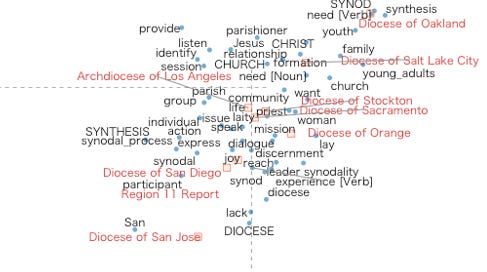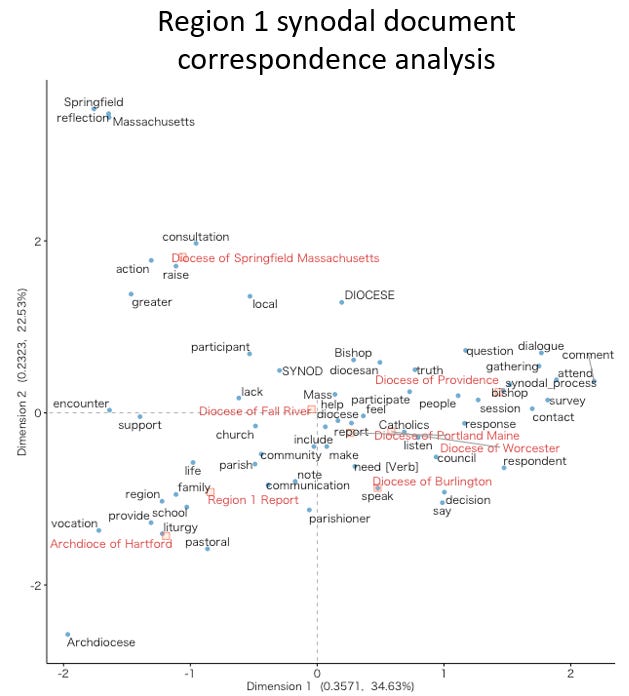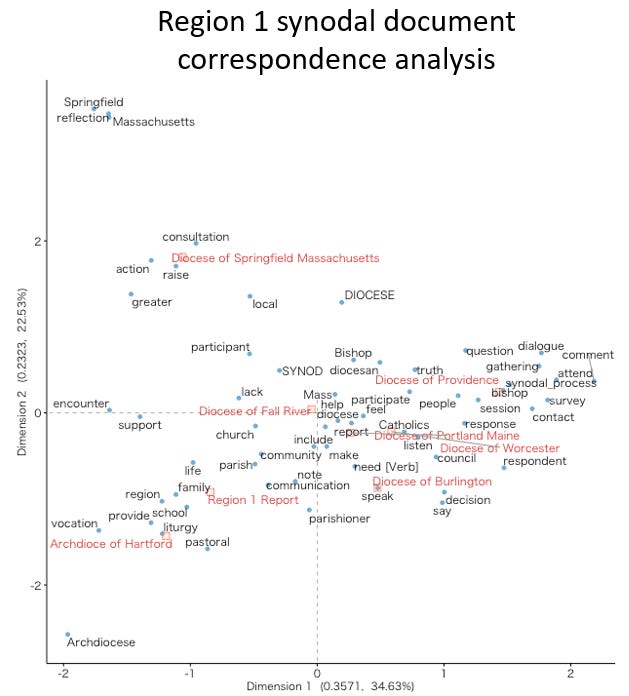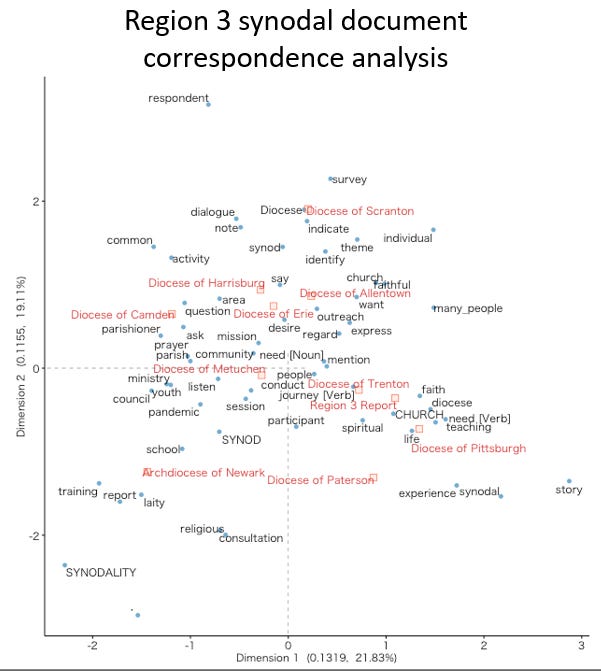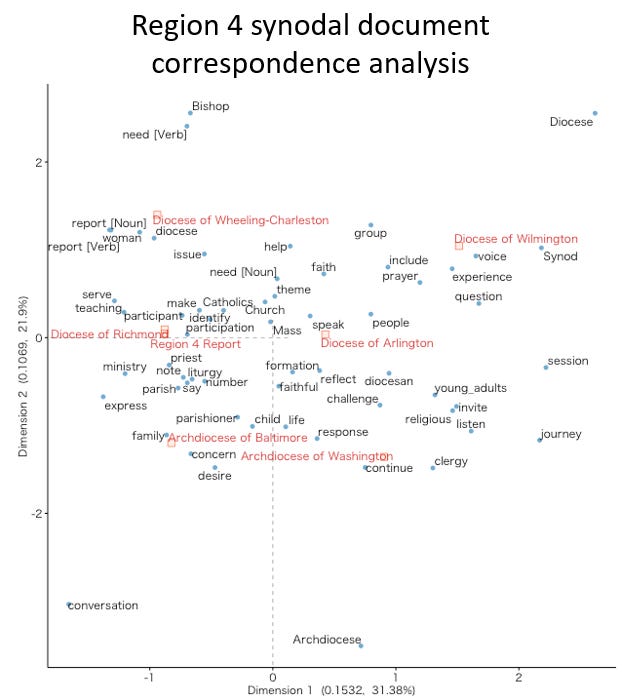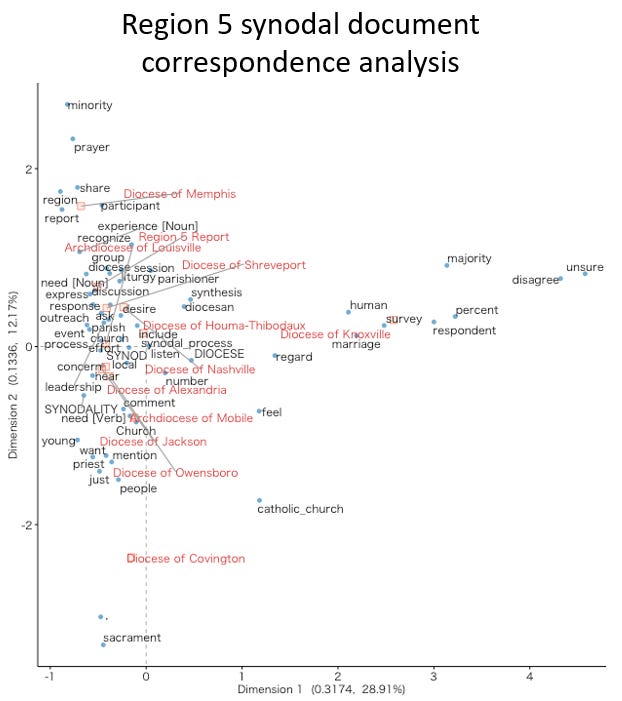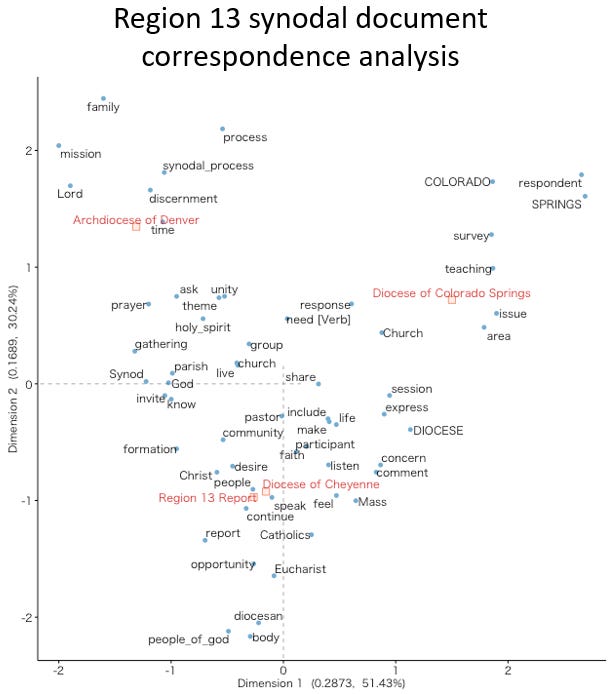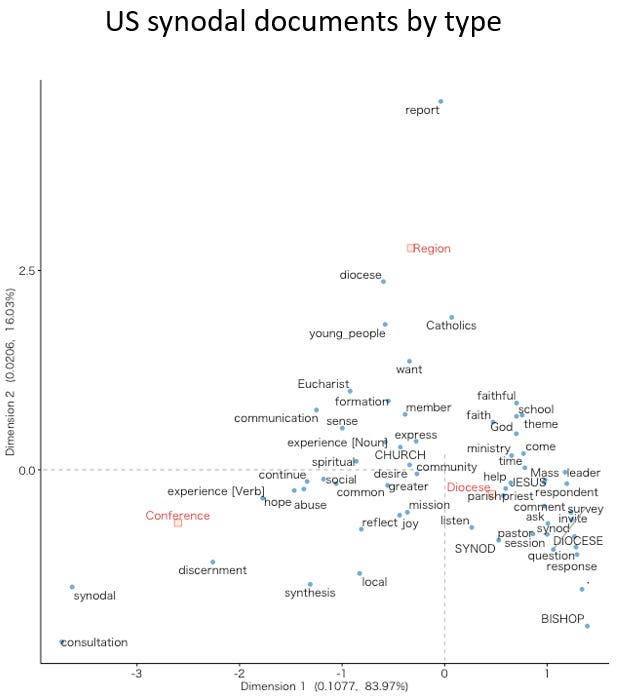
The 'synodal style' - A correspondence look at US synod reports
Can 'correspondence analysis' say anything about the synod on synodality?
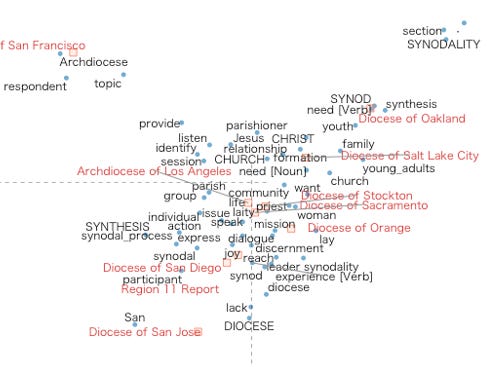
As the Church’s global synod on synodality begins its “continental phase,” it’s very likely the process has thus far produced reports containing something in the order of nine million words.
The average U.S. diocese produced a synodal summary document of 3,998 words — about 10 pages. If all 2,248 Catholic dioceses in the world produced similar reports, the sum total would come close to nine million.
In the U.S., in other countries, and at the Vatican, organizers of the synodal process have faced the monumental challenge of synthesizing synodal documents from around the world — drawing key themes and ideas from meetings, at the diocesan level, or from diocesan and regional documents, at higher levels. Organizers have emphasized that in their view, that process is qualitative, not quantitative. That makes the accuracy of the process difficult to assess.
While a quantitative look at synodal reports does not capture the reasons for choices made, it can give some insight into how synod documents compare to each other, and how they were produced.
To take a shot at gleaning that kind of analysis, The Pillar has collected the texts of all available diocesan synodal syntheses in the U.S., along with the regional and national synthesis documents for the US.
We also collected the text from the global “Working Document for the Continental Stage” and from the 17 other national synthesis documents from around the world which were published in English.
Our plan is to use several kinds of textual analysis to evaluate the synodal documents. There are limits to this kind of analysis — but there are also insights that can be gleaned.
Last month, The Pillar created some word clouds, to assess the frequency with which some words were used in synodal documents.
This month, we’ve got another approach: We used a suite of software called KH Coder (primarily used by academics to conduct quantitative content analysis) to analyze and compare patterns and usage in those documents.
Using a technique called correspondence analysis, it is possible to compare the words and phrases used in multiple documents, to see which distinctive words they have in common and which ones set them apart from each other.
What can be learned from this process?
Well, on one hand, correspondence analysis shows nothing but patterns, and frequency relationships — data that by itself might prove very little. But on the other hand, those patterns make suggestions — and in the case of the synod on synodality in the U.S., they suggest marked breaks in style and approach at each level of synodality synthesis.
Read on to see what we mean.
Pastoral: 12/10,000
The data visualization below is a correspondence analysis for one ecclesiastical region of the United States — Region 1, which consists of the dioceses in New England, in Massachusetts, Connecticut, Maine, Vermont, and New Hampshire.
The visualization looks at the published synodal reports for dioceses in Region 1, and the regional synthesis report for the same region:
The analysis focuses on the most frequently appearing distinctive words that appear in the data set.
Distinctive words are those which appear more commonly in the data set than in an average passage of English writing. An extremely common word, like “a” or “that,” will not appear in this textual analysis because it will be equally common in any document written in English.
By contrast, a word like “synod” would not appear frequently in an average English document but does appear frequently in the synodal documents. Thus, “synod” will appear as one of the distinctive words in the analysis
Words that appear near the spot where the horizontal and vertical axes intersect - the 0,0 origin point - are words that appear with similar frequency throughout all documents in Region 1.
Words that appear more frequently in some documents than in others are plotted further from the origin point. The more lopsided a word’s representation in the data set, the further from the origin point it will appear.
The seven diocesan documents and the regional synthesis document are also plotted on the graph.
The analysis shows a few things.
First, the synod report for the Diocese of Fall River is the closest report to the origin point of the graph – that means its text is closest to the average usage of words and phrases across the entire region.
Here’s an example: the Diocese of Fall River used the word “pastoral” 12 times per 10,000 words, an average frequency for the Region 1 data set. The Archdiocese of Hartford used the word “pastoral” most frequently, at a rate of 21 times per 10,000 words. Because Hartford used “pastoral” most often, the word appears at the bottom left of the graph, very near where the Archdiocese of Hartford is plotted.
The Diocese of Providence used the word “pastoral” less frequently than the average - seven times per 10,000 words - and the diocese is thus plotted to the right of the graph, on the opposite side of the origin point from where the word “pastoral” is plotted – the distance shows that Providence used the word less often than the average.
The Diocese of Springfield used the word “pastoral” least of all, just three times per 10,000 words, so the diocese is plotted at the upper left, the furthest from where “pastoral” is plotted.
“Liturgy” is another example.
The word “liturgy” is plotted closest to the Archdiocese of Hartford, whose synodal report used “liturgy” 15 times per 10,000 words. By comparison, the Diocese of Providence mentioned liturgy once per 10,000 words and the Diocese of Springfield used the word three times per 10,000 words.
You might have noticed that the Region 1 report - its regional synthesis document - is plotted closest to the Archdiocese of Hartford on the graph.
That placement shows that the Hartford report and the Region 1 report have more similar usage frequency than other reports. The closeness of those reports could suggest that the Region 1 report was most influenced by the Archdiocese of Hartford report, especially if some of the concepts they shared were very distinctive.
Of course, language patterns - word frequency and usage - cannot alone definitively establish which diocesan reports most influenced a regional report. The similarities only note a correlation. But the correlation is there – in a correspondence analysis, both the Hartford report and the regional synthesis were far from the origin point, and relatively close to one another.
Below are the correspondence analysis graphs for all 14 regions of the Latin Church in the USCCB. Region 15 consists of the Eastern Catholic eparchies in the United States and did not publish a synodal summary document.
An additional synodal report, published under the title "Region 16", was created as summary of synodal reflections contributed by Catholic organizations, universities, religious orders, and other non-diocesan participants.
Because the individual reports summarized under Region 16 are not available online, there is not a Region 16 graph in this analysis, but the Region 16 synthesis report is plotted in the national graphs below.
Region 1
Archdiocese of Boston
Diocese of Bridgeport
Diocese of Burlington
Diocese of Fall River
Archdiocese of Hartford
Diocese of Manchester
Diocese of Norwich
Diocese of Portland
Diocese of Providence
Diocese of Springfield in Massachusetts
Diocese of Worcester
Start your day with Starting Seven - a daily news roundup in your inbox.
Region 2
Diocese of Albany
Diocese of Brooklyn
Diocese of Buffalo
Archdiocese of New York
Diocese of Ogdensburg
Diocese of Rochester
Diocese of Rockville Centre
Diocese of Syracuse
Region 3
Diocese of Allentown
Diocese of Altoona-Johnstown
Diocese of Camden
Diocese of Erie
Diocese of Greensburg
Diocese of Harrisburg
Diocese of Metuchen
Archdiocese of Newark
Diocese of Paterson
Archdiocese of Philadelphia
Diocese of Pittsburgh
Diocese of Scranton
Diocese of Trenton
📰
Region 4
Diocese of Arlington
Archdiocese of Baltimore
Diocese of Richmond
Diocese of Saint Thomas in the U.S. Virgin Islands
Archdiocese for the Military Services, USA
Archdiocese of Washington (District of Columbia)
Diocese of Wheeling-Charleston
Diocese of Wilmington
Region 5
Diocese of Alexandria
Diocese of Baton Rouge
Diocese of Biloxi
Diocese of Birmingham
Diocese of Covington
Diocese of Houma-Thibodaux
Diocese of Jackson
Diocese of Knoxville
Diocese of Lafayette in Louisiana
Diocese of Lake Charles
Diocese of Lexington
Archdiocese of Louisville
Diocese of Memphis
Archdiocese of Mobile
Diocese of Nashville
Archdiocese of New Orleans
Diocese of Owensboro
Diocese of Shreveport
__
Region 6
Archdiocese of Cincinnati
Diocese of Cleveland
Diocese of Columbus
Archdiocese of Detroit
Diocese of Gaylord
Diocese of Grand Rapids
Diocese of Kalamazoo
Diocese of Lansing
Diocese of Marquette
Diocese of Saginaw
Diocese of Steubenville
Diocese of Toledo
Diocese of Youngstown
Region 7
Diocese of Belleville
Archdiocese of Chicago
Diocese of Evansville
Diocese of Fort Wayne-South Bend
Diocese of Gary
Diocese of Green Bay
Archdiocese of Indianapolis
Diocese of Joliet
Diocese of La Crosse
Diocese of Lafayette in Indiana
Diocese of Madison
Archdiocese of Milwaukee
Diocese of Peoria
Diocese of Rockford
Diocese of Springfield in Illinois
Diocese of Superior
📰
Region 8
Diocese of Bismarck
Diocese of Crookston
Diocese of Duluth
Diocese of Fargo
Diocese of New Ulm
Diocese of Rapid City
Diocese of Saint Cloud
Archdiocese of Saint Paul and Minneapolis
Diocese of Sioux Falls
Diocese of Winona-Rochester
Region 9
Diocese of Davenport
Diocese of Des Moines
Diocese of Dodge City
Archdiocese of Dubuque
Diocese of Grand Island
Diocese of Jefferson City
Archdiocese of Kansas City in Kansas
Diocese of Kansas City-Saint Joseph
Diocese of Lincoln
Archdiocese of Omaha
Archdiocese of Saint Louis
Diocese of Salina
Diocese of Sioux City
Diocese of Springfield-Cape Girardeau
Diocese of Wichita
__
Region 10
Diocese of Amarillo
Diocese of Austin
Diocese of Beaumont
Diocese of Brownsville
The Personal Ordinariate of the Chair of Saint Peter
Diocese of Corpus Christi
Diocese of Dallas
Diocese of El Paso
Diocese of Fort Worth
Archdiocese of Galveston-Houston
Diocese of Laredo
Diocese of Little Rock
Diocese of Lubbock
Archdiocese of Oklahoma City
Diocese of San Angelo
Archdiocese of San Antonio
Diocese of Tulsa
Diocese of Tyler
Diocese of Victoria
Region 11
Diocese of Fresno
Diocese of Honolulu
Diocese of Las Vegas
Archdiocese of Los Angeles
Diocese of Monterey
Diocese of Oakland
Diocese of Orange
Diocese of Reno
Diocese of Sacramento
Diocese of San Bernardino
Diocese of San Diego
Archdiocese of San Francisco
Diocese of San Jose
Diocese of Santa Rosa
Diocese of Stockton
__
Region 12
Archdiocese of Anchorage-Juneau
Diocese of Baker
Diocese of Boise
Diocese of Fairbanks
Diocese of Great Falls-Billings
Diocese of Helena
Archdiocese of Portland
Archdiocese of Seattle
Diocese of Spokane
Diocese of Yakima
Region 13
Diocese of Cheyenne
Diocese of Colorado Springs
Archdiocese of Denver
Diocese of Gallup
Diocese of Las Cruces
Diocese of Phoenix
Diocese of Pueblo
Diocese of Salt Lake City
Archdiocese of Santa Fe
Diocese of Tucson
__
Region 14
Archdiocese of Atlanta
Diocese of Charleston
Diocese of Charlotte
Archdiocese of Miami
Diocese of Orlando
Diocese of Palm Beach
Diocese of Pensacola-Tallahassee
Diocese of Raleigh
Diocese of Saint Augustine
Diocese of Saint Petersburg
Diocese of Savannah
Diocese of Venice
‘Synodal style’
During a press briefing about the synod on synodality at this month’s meeting of the USCCB, Bishop Daniel Flores, who is responsible for coordinating the USCCB’s contributions to the synod, talked about developing a “synodal style” within the Church.
Textual analysis suggests that in fact the Catholic Church in the U.S. has three different synodal styles, or at least three different synodal vocabularies.
Analyzing all available U.S. documents revealed significant differences between diocesan reports taken as a group, regional syntheses, and the USCCB’s national synthesis document.
Take a look:
Diocesan reports spoke more often about the local institutions of Catholic life, mentioning parishes and schools more often than the regional and conference level documents did. Diocesan reports also spoke more frequently about God, Jesus, and the Mass.
Indeed, God was mentioned five times as often in the diocesan documents as in the national synthesis prepared by the USCCB.
The regional and national-level reports spoke more often about the Eucharist, and also discussed the abuse crisis more often.
The national synthesis document also stood out from the regional and diocesan documents in its use of terminology specific to the synod on synodality.
The frequency of the words “synodal” and “synodality” was more than twice as high in the national document as in the regional and diocesan ones. And the national document referred to “discernment” three times as often as did diocesan and regional documents.
While regional documents as a whole were significantly different from the national document, we were curious whether some individual regional summaries were closer to the national document.
The graph below shows a correspondence analysis of only the national document and the regional summaries. Most regional documents are clustered at the upper right, on the opposite side of the origin point from the national document — indicating that the frequency with which they use words and phrases is different from the national document.
But Region 7, which includes the upper midwest and Chicago, and Region 12, which includes the Pacific Northwest and Seattle, were the most similar to the national document. Those documents referenced consultation, the “People of God,” the Eucharist, and synodality more than the average region.
Shifting emphases?
Of course, the process of the synod on synodality is in many ways unique.
Rather than being asked to discern the particular state and needs of their flocks, diocesan bishops were asked by the Vatican’s synod secretariat office to summarize and pass on local synodal reports.
But textual analysis suggests that while the regional and national U.S. documents may have intended to fulfill this task, it’s possible they created texts which both summarized and introduced or emphasized new content.
If the process of correspondence analysis can successfully offer a view into the spectrum of diocesan documents from across the United States, it appears that the original diocesan synodal documents mentioned significantly more often parish life, God, and the Mass than did the national synthesis text.
The regional syntheses brought their own change in emphasis, talking about parish life and Jesus less than diocesan document, but adding emphasis on the Eucharist, amid an emphasis on a Eucharistic Revival in the U.S. Church, which may well have been on the minds of those working to summarize the documents.
The national synthesis in turn brought new focus to certain issues that were not present or prominent in the lower-level synodal documents. In particular, the national summary focused more on the abuse crisis in the Church, and on the notion of synodal discernment itself, than did the documents which it was tasked to summarize.
As the synod seeks to reflect on the synodal process at the continental and finally global level, these changes in emphasis as synodal documents are summarized and passed on to higher levels may come to have significant effects on the Church’s understanding of the issues brought up by members of the faithful.
__
In the next installment of The Pillar's textual analysis, we'll look at national reports from around the globe, and the Vatican-issued “Working Document for the Continental Stage.”
After that, we'll take a look at what thematic "coding groups" can also about how synod documents talked about some controversial synodal topics.

